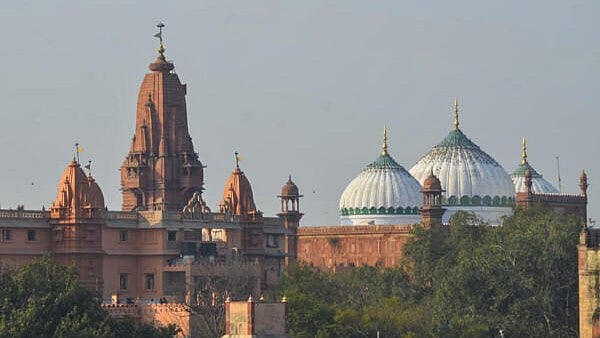
Shahi Idgah mosque and Shri Krishna Janmabhoomi Temple, in Mathura. (For representational purpose)
Credit: PTI File Photo
The Places of Worship (Special Provisions) Act is a succinct law comprising a preamble and an operative clause that criminalises the 'conversion' of a place of worship.
DH's Sumit Pande explains the significance of the law that has been challenged before the Supreme Court.
Why was the Places of Worship Act, 1991, enacted?
At the peak of the Ram Janmabhoomi-Babri Masjid dispute in the early nineties, the PV Narasimha Rao-led Congress government at the Centre brought the Places of Worship (Special Provisions) Act, 1991.
The law prohibits the conversion and mandates the maintenance of any place of worship as it existed on August 15, 1947.
Introducing the bill, the then Home Minister SB Chavan said the law was enacted "in view of the controversies… which tend to vitiate the communal atmosphere."
What are the contentious provisions of the law?
Almost all the debates centre around three key clauses: Sections 3-5. Section 3 states that the ‘conversion’ of a place of worship from one religion or sect to another is a criminal act.
Section 4 stipulates August 15, 1947, as the cutoff date to determine the character of a place of worship. Section 5 excludes the application of the law to the Ram Janmabhoomi-Babri Masjid site.
Ironically, soon after the enactment of the law, the disputed structure in Ayodhya was demolished by Kar Sewaks on December 6, 1992.
Why was the validity of the 1991 Act challenged?
Months after the SC adjudicated on the Ram Temple title suit in 2019, the Places of Worship Act was challenged by petitioners, including BJP spokesperson and advocate Ashwini Kumar Upadhyay.
The petitions sought to declare Sections 3, 4 and 5 unconstitutional, arguing that the act bars judicial review and violates the basic structure of the Constitution. They also contend that the statute violates the right to freedom of religion as envisaged under Articles 25, 26 and 29.
What is the opposition to the petitions challenging the 1991 Act?
The All India Muslim Personal Law Board, the apex body advocating for Muslim interests in India, posited that courts should not allow challenges to a central law protecting religious places, as it is enshrined in the basic structure of the Constitution.
After more than a year since its last listing before the SC on November 30, 2023, the matter was heard on Thursday.
What did the SC say in the Ram Temple title dispute judgment?
The five-judge verdict held that "law was a legislative instrument designed to protect the secular features of the Indian polity".
While awarding the disputed site to Ram Lala (deity) Virajmaan, the SC stated that similar cases could not be entertained concerning other sites in view of the 1991 Act.
What led to the rise in 'religious places' litigations before lower courts?
While challenges to the Places of Worship Act are pending before the Supreme Court, several civil suits have emerged in lower courts, contesting the character of prominent religious places. Some petitions followed the SC's favourable ruling on the Ram Temple title suit.
A Rajasthan court recently issued a notice in a petition claiming Ajmer Sharif Dargah was originally a Shiva temple.
In Uttar Pradesh’s Sambhal, a court ordered an Archaeological Survey of India (ASI) inspection of the Shahi Jama Masjid. Similarly, in 2023, a Varanasi court ordered the ASI to start the “scientific investigation” of the Gyanvapi mosque premises.